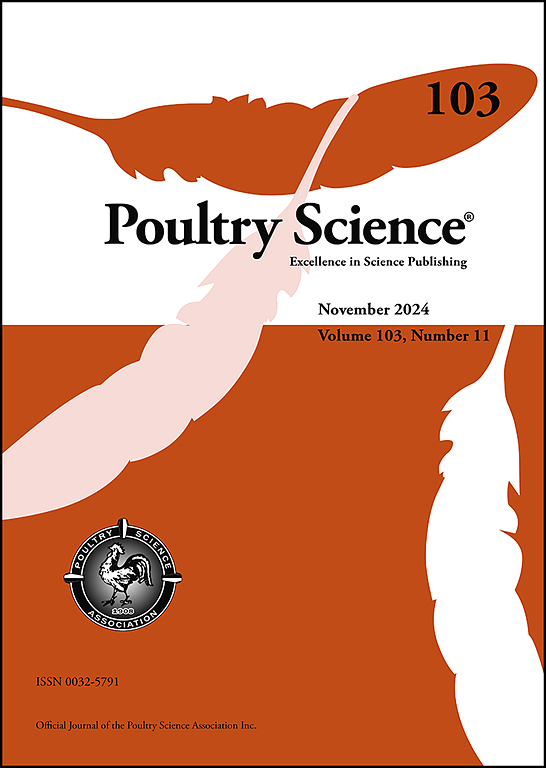Impact of heat stress on phenotypic and genetic parameters of egg fertility traits in four Thai native synthetic chicken lines
IF 3.8
1区 农林科学
Q1 AGRICULTURE, DAIRY & ANIMAL SCIENCE
引用次数: 0
Abstract
Heat stress affects chickens as well as their eggs. Therefore, the objective of this study was to identify the temperature threshold at which heat stress began to negatively affect fertility traits and to estimate the genetic parameters of egg fertility (FER) in Thai native synthetic chicken lines under different thermal conditions. A total of 392,995 egg records from 5,919 individuals of four Thai synthetic chicken lines—Soi Nin, Soi Pet, Kaen Thong, and Kaimook e-san—were used in this study. FER, hatchability of fertile eggs (HOF), and hatchability of egg sets (HOS) were measured from 7 to 52 weeks of production. A multiple-trait random regression test-day model based on the temperature-humidity index (THI), which is calculated from ambient temperature and relative humidity, was used to estimate the onset of heat stress, genetic parameters, and losses in FER, HOF, and HOS. The results identified a THI value of 76 as the threshold at which fertility heat stress began to negatively affect egg fertility traits in all chicken lines, based on the highest R² and lowest MSE across all traits. The estimated direct heritability values for FER, HOF, and HOS ranged from 0.060 to 0.074, 0.040 to 0.049, and 0.037 to 0.046, respectively. The mate sires heritability values were higher, ranging from 0.112 to 0.132 for FER, 0.121 to 0.149 for HOF, and 0.118 to 0.149 for HOS. Genetic correlations among egg fertility traits were high (> 0.80), while their correlations with heat stress were strongly negative in all lines. Permanent environmental correlations were positive among the fertility traits (0.59 to 0.85) but negative in relation to heat stress (−0.80 to −0.92). Among the four lines, Kaimook e-san showed the greatest reduction in fertility under heat stress, whereas Soi Nin exhibited the least decline. These findings demonstrate that heat stress has a strong effect on egg fertility traits and genetic parameters of Thai synthetic chicken lines, supporting the use of THI-based models in breeding for heat tolerance.
求助全文
约1分钟内获得全文
求助全文
来源期刊

Poultry Science
农林科学-奶制品与动物科学
CiteScore
7.60
自引率
15.90%
发文量
0
审稿时长
94 days
期刊介绍:
First self-published in 1921, Poultry Science is an internationally renowned monthly journal, known as the authoritative source for a broad range of poultry information and high-caliber research. The journal plays a pivotal role in the dissemination of preeminent poultry-related knowledge across all disciplines. As of January 2020, Poultry Science will become an Open Access journal with no subscription charges, meaning authors who publish here can make their research immediately, permanently, and freely accessible worldwide while retaining copyright to their work. Papers submitted for publication after October 1, 2019 will be published as Open Access papers.
An international journal, Poultry Science publishes original papers, research notes, symposium papers, and reviews of basic science as applied to poultry. This authoritative source of poultry information is consistently ranked by ISI Impact Factor as one of the top 10 agriculture, dairy and animal science journals to deliver high-caliber research. Currently it is the highest-ranked (by Impact Factor and Eigenfactor) journal dedicated to publishing poultry research. Subject areas include breeding, genetics, education, production, management, environment, health, behavior, welfare, immunology, molecular biology, metabolism, nutrition, physiology, reproduction, processing, and products.
 求助内容:
求助内容: 应助结果提醒方式:
应助结果提醒方式:


